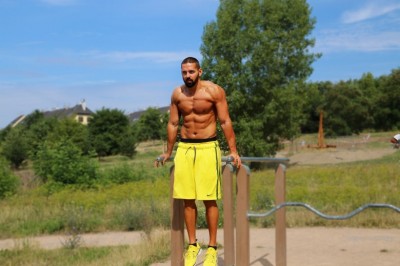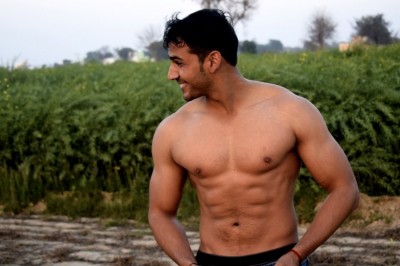How to Build a Big, Thick, Powerful Chest
If you are a dedicated weight trainer what is the first thing you are asked when people notice your physique?....."How Much Can You Bench?" Why? Because it is the original ego-lift and is one of the foundation exercises employed to build a big chest.
Every man and boy (and some woman) who join their first gym or pick up their first weight has an innate, primary instinct to build up their chest.
A big chest seems to symbolize masculinity and a man who carries a big chest commands respect and attention.
I have said before that to be Mr Olympia you need to blow away the competition with an amazing back (i.e. Dorian, Ronnie, Cutler, Haney etc). Having said that you can see quite clearly that EVERY Mr Olympia winner has had a big, thick, powerful chest.
Arnold and Franco Columbo may well have had the best chests of all time and although they had assistance from certain ergogenic aids (use your imagination) they still had to train very hard with the right exercises, the right program structure and mountains of intensity. Check out these amazing images... WOW!
Now, realistically, not everyone is going to grow a chest like these two boys. Apart from hard work and said ergogenic aids they also had pretty damn decent genetics and did everything right without much of a struggle.
Having said that I have observed hundreds of clients and training partners and thousands of gym members and weight trainers over the last 15 years and I can list all of the anomalies that hold people back from building a good chest. Keep them in mind when you are training...
1. Scapula Retraction
Definitely the most important rule when performing any chest exercise. You must be able to pull your shoulders back and down and hold your shoulder blades (scapula) together during the entire repetition of any chest exercise. This allows you to isolate the pectorals fully causing maximum muscle fiber activation. People who find this difficult, and Ill explain why later, never experience a complete Pec contraction and tend to fatigue the shoulders before the chest.
2. Spinal Curvature and Flexibility
This is what a healthy and normal spine looks like and you can see it has several natural curves which provide many functions relating to posture, movement, force absorption, neural network/protection, flexibility etc. Concerning chest development I have noticed that if people have a flat or straight spine, i.e. less pronounced curves, they have a lot more trouble arching their back to properly perform scapula contraction during chest exercises. I have also observed that flatter-spined weight trainers seem to have less room in their torsos to build thicker Pecs while those with more pronounced curves are able to do so.
3. Dominant Deltoids and Triceps
Those lucky to be blessed with a large pair of cannon-ball shoulders (delts ) and horse-shoe triceps may find it difficult to isolate the Pecs in chest movements as these two muscle groups can easily dominate and take over. This means that the chest is never fully worked and is always trying to play catch-up.
4. Weak Deltoids and Triceps
Conversely a pair of less developed delts and triceps can hamper the productivity of a chest workout by giving out before the chest is fully fatigued. If you are performing a pressing movement where the delts and triceps are heavily involved and they give out first then the set is over and the Pecs are left under-stimulated.
5. Starting From Scratch
If you are a beginner it is hard to feel the chest contracting properly during a set. You not only have a poor mind-muscle connection (the ability of the motor cortex in your brain to send messages to the motor neurons commanding all the muscle fibers to contract) you also, most likely, have a thin pectoral muscle which has no discernable contraction. In this case technique and mental focus is extremely important and once the first hard-won bit muscle is built it actually becomes easier to feel the contraction and continue the growth process.
6. Poor Flexibility
This relates back to point 1 and 2. If your upper body flexibility is poor, i.e. your shoulder joints have reduced range of motion and your spine has deviated from the most optimal curves (bad posture), then arching your back and performing scapula retraction become much more difficult. Training with poor posture and flexibility also increase the risk of injury.
The Golden Rules of Chest Training
1. Scapula Retraction
The ability to hold the shoulder blades together during chest exercises will withdraw shoulder involvement from the movement isolating the chest building tone, size and strength.
2. Arching the Back
Arching the back when setting the body position for a chest exercise will allow full scapula retraction and the ability to build chest thickness.
3. Perfect Technique
I have written a two and half thousand word article about this subject. It is called The Perfect Rep: Unlocking the Secret for Permanent, Effective Training. Please read this if you want to take your body to its full potential. In a nutshell:
* Accentuate the negative (release the weight slowly)
* Perform the positive phase (lifting the weight) with controlled force
* Use a full and appropriate range of motion
* Achieve a noticeable stretch and contraction
* Exhale when exerting force to lift
* Focus on the action of the pectoral muscle during the exercise
* Make sure you are using the correct movement pattern
* Set and maintain perfect body position
4. Focus on Free-weights and Compound Movements
Big, thick, powerful Pecs are built from a focus on barbell presses, dumbbell presses and weighted dips. Next in line of duty are plate-loaded machine presses, pin-loaded machine presses, smith presses, cable presses and push-ups. Last we come to cable/dumbbell/machine flyes and pec deck. To explain why free-weight, compound exercises are essential for building size and strength I will include this excerpt from and article I wrote called: 10 Awesome Compound Exercises That You Should Never Miss Out On...
What Are The Benefits Of Employing Compound Movements?
* They are time-efficient because many muscles are trained in a single exercise. If you are using isolation exercises more are required because fewer muscles are involved.
Example: A Push-press trains the shoulders, triceps, quads, glutes and a range of ancillary muscles. If you were performing isolation exercise to train these muscles you would need to do lateral raises, tricep extensions, leg extensions, hip extensions and more to emulate the same amount of muscular stimulation.
* There is a greater capacity to build mass and strength. This is because heavy loads can be applied safely with the pressure divided between multiple joints and muscle groups all contributing varying levels of force.
* Inter-muscular coordination is learned through different muscle groups and joints interacting to execute a large, complex movement with synchronized efficiency. This means that the muscles become a powerful team that work well together.
* There is a reduced risk of injury (if good technique is always applied). With compound movements the load and stress is shared between many muscle groups and joints. During an isolation movement a single joint must handle the lot.
* You must build a strong core and mid-section. If you intend to lift heavy weights with good technique and intensity your abdominals, lower back and the inner muscles of the spine must be strong. Focusing on compound exercises will stabilize your body and keep you safe. Build up the weights slowly and engage your abs and core all the time.
* A positive hormonal environment is created when big muscles are stimulated with big exercises. When you focus on the big exercises larger amounts of growth hormone and testosterone are released into the system to support your bodys battle with the heavy weights.
* The cardio-vascular system is more heavily involved because the greater amount of large muscles working in compound movements require increased quantities of blood and oxygen. This of course must be supplied by the heart and lungs.
5. Intensity
You must push yourself safely towards absolute muscular failure to get an over-compensation response from the body that will result in a strength and growth increase.
6. Warm-up Correctly and Stretch Between Sets
* 5 minutes light cardio on a machine that involves all the upper and lower body
* Some light stretches
* Pyramid warm-up set weights on your first chest exercise before you get to your work sets. Example: Bench Press - 40kg x 20 reps, 60kg x 15 reps, 80kg x 10 reps, 100kg 2 x 8 reps
* Perform work sets only after your first exercise
* Perform medium chest stretches between sets to increase blood flow, recovery and flexibility
* Perform heavy stretches at the end of your workout
7. Exercise and Set Volume
Choose 5-8 exercise and perform 2 work sets per exercise. This will give you are variety of angles and directions to work through covering every area of the chest. You will also be able to focus your intensity on performing two hard sets rather than spreading your power over several sets.
With all these extremely important points in mind I will now give you an infallible chest program not unlike what I do in my own training sessions. There will be two programs to choose from. Each has its own unique structure but both will deliver the same result: A Big, Thick, Powerful Chest...
Joey Sheather is the head trainer at Global Weight Training, which provides step-by-step instructions on how to get into shape in the shortest possible time. For more information, visit Weight Training.


























